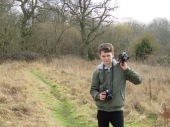This week I’ve been really honoured to hear that a local primary school have been using my blog to help them learn about ‘living things and their habitat’ during their science lessons.
What was really amazing was the variety of questions and thought that has gone in to each question they have sent me to answer.
To the Children of Years 1 and 2 from Woodstock Primary School, here are my answers.
1. How do you photograph animals that move so fast?
With difficulty.
I use a setting on my camera that takes lots of photos, one after the other really quickly. Sometimes I have to guess where an animal is going to run to, then focus on one place and hope that the animal will pass that spot.
Hares can be quite hard, but insects like dragonflies can be impossible to take a photo of in flight, sometimes it is easier to film them.
You would be amazed at how many photos I have to delete. Like the one below.

2. Why do you like nature?
Nature is absolutely fascinating, there is always something new to learn and something new to discover, a species or a behaviour that you have never seen before.
Just this week I learnt all about the journey that Swallows take when they migrate to South Africa.

3. Where is the best place in Oxfordshire to watch wildlife?
My favourite place is my local patch. If you spend the time to learn where each animal lives or is likely to appear, then an area you know well is always the best place to see wildlife.
Other than my local patch, the Wildlife Trust Nature Reserves such as Dry Sandford Pit, or RSPB reserves like RSPB Otmoor are great places to visit.

One of my favourite places in Oxfordshire is Wytham woods.

4. Is it difficult to reach the right places to see animals? Do you climb over trees and rocks?
Sometimes I have to climb over and around things. I think Brambles are probably the thing that gets in the way the most when I am trying to take photos, lots of animal use brambles for shelter and hiding in.
5. How many peregrine falcons are living and have you seen any?
According to the RSPB there are 1,500 breeding pairs in the UK. I have been lucky enough to see two Peregrine falcons at RSPB Otmoor. I also took a quick photo of one flying over my house a couple of years ago and I’ve seen one on a cliff in Devon.
6. How many animals are getting extinct at the moment? What animal has the lowest number?
When we think about extinction we normally think about White Rhino’s, polar bears and Cheetahs, the big mammals, but Scientists estimate that 150 – 200 species of plant, insect, bird and mammal become extinct every 24 hours, or between 200 and 2,000 species each year depending on which study you read.
Many of these are from ‘natural extinction’ and would have happened even if humans had nothing to do with it, but humans do effect lots of animals and their survival.
Animals such as the White Rhino and the Vaquita porpoise have very low numbers.
7. What is your favourite animal and why?
Badgers are my favourite animals, with Hares coming a close second.
I have been watching my local badger sett for over 10 years and each badger has its own personality, some are playful and cheeky. Others are bossy and push other badgers around. I admire how powerful and strong they are.
Hares are fantastic to watch, they are so fast especially when they are chasing each other before they start boxing.

8. How many hedgehogs are living?
It is very difficult to know how many hedgehogs there are in the UK, some think only around 1 million hedgehogs are left which is shocking when in the 1950’s there were 36.5 million hedgehogs.
There is lots you can do to try and help hedgehogs and encourage them in to your back garden. Have a look at Hedgehog Street.
The hedgehog in my garden loves slugs.
9. How long have you been looking for animals?
I have been looking for animals since I was 3 years old when my parents had to carry me down to the woods to see the badgers, as it was too far for me to walk. I’ve always been interested in animals especially mammals.
10. How many different types of animal have you seen in Oxfordshire?
Wow, that’s a hard question. I have no idea. I have probably only seen a very very small percentage of all the mammals, birds, insects, fish, moths and butterflies in Oxfordshire. That is why nature is so fascinating because there is always something new to find even in your own back garden.
The mammals are easy I have seen Badgers, hares, roe deer, fallow deer and muntjac, rabbits, different types of mice, voles and shrews, rats, hedgehogs, grey squirrels, mink, stoat, weasel, polecat and foxes, bats and moles.
I have seen Otters and water voles, but not in Oxfordshire. I would love to see a wild boar and a beaver.
There are 294 types of birds in Oxfordshire, although some of those just visit or have only been seen once and some not for a very long time.
My favourites are the birds of prey and I’d love to see a Red-footed falcon. One was seen this week in Oxfordshire.
11. How do you look after nature?
You can look after nature by respecting it. We all have to share this planet and we all have the right to have somewhere to live and grow.
There are plenty of things each one of us can do every day such as not dropping litter, putting out water in the garden and little actions like not killing that spider you find in the bath, but picking it up and letting it go.
The best way to look after nature is to learn more about it, the more you know the more you will care about it.

Thank you for such interesting questions. Good luck with your science lessons.
Alex






























I love this – so important to encourage enjoying and respecting nature from a really young age and I love the thought of your parents carrying you to watch badgers when you were so small. I am a mum and it shocks me when I meet children and parents who have no connection with nature or find it scary, so it is very inspiring to read blogs like yours.
LikeLiked by 1 person
Thank you for your comment
LikeLike
Alex, your enthusiasm is such an inspiration to other naturalists – and not just young ones. You should be very proud.
LikeLiked by 2 people
Alex – thank you so much for brilliantly answering our questions. I am really looking forward to sharing your blog post with the class. You have been so helpful and it is definitely inspiring reading your thoughts on this subject. Hopefully pupils will enjoy exploring the wildlife in their patch and the wild spaces of Oxfordshire over the summer. Thanks again.
LikeLiked by 3 people
The questions certainly made me think
LikeLiked by 1 person